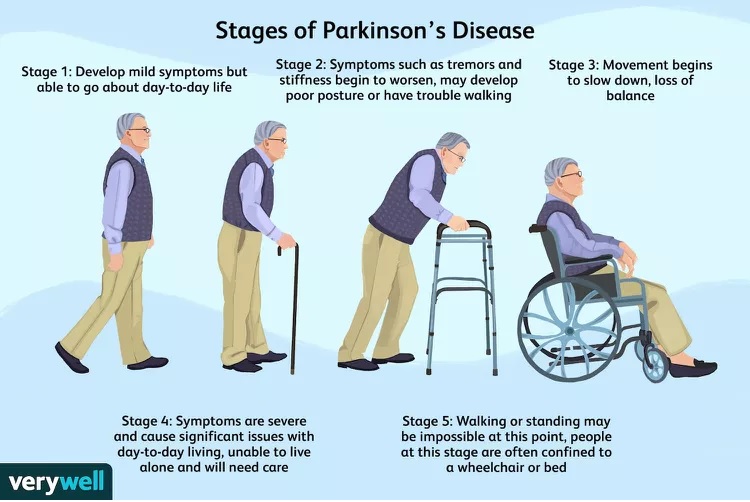What is Parkinson’s disease?
Parkinson’s disease is a progressive neurogenerative disease that causes nerve cells (or neurons) in the area of the brain that controls movement to weaken and/or die. While healthy neurons produce a chemical called dopamine, which the brain needs a certain amount of in order to regulate movement, weakened neurons produce lower levels of dopamine.
What are the symptoms of Parkinson’s disease?
Following are the common symptoms of Parkinson’s disease often begin gradually and progress over time:
- Shaking or tremor
- Slowing of body movements (bradykinesia)
- Difficulty walking
- Unsteady balance
- Rigid muscles
- Poor posture
As the disease continues to progress, additional symptoms can occur such as slurred or soft speech, trouble chewing and/or swallowing, memory loss, constipation, trouble sleeping, loss of bladder control, anxiety, depression, inability to regulate body temperature, sexual dysfunction, decreased ability to smell, restless legs and muscle cramps.
How is it diagnosed?
There is no blood test or scan that can diagnose Parkinson’s disease. Neurologist look for four classic symptoms of the disease before reaching a diagnosis: tremors, rigidity in the wrist and elbow joints, lack or slowness of movement, and an unstable posture.
IMPORTANT FACTS REGARDING PARKINSON’S DISEASE:
1. People with Parkinson’s can have a good quality life.
There is no one-size-fits-all treatment approach when it comes to PD. While medication is the most common treatment, surgical therapy and lifestyle modifications, like rest and exercise, help manage the disease. With proper medications, people with Parkinson’s can live a normal healthy life.
2. No two people have the same exact symptoms.
The progression of symptoms is often a bit different from one person to another due to the diversity of the disease. People with PD may experience: tremor (mainly at rest); slowness of movements (bradykinesia); limb rigidity; gait and balance problems
3. Non-motor symptoms can be more troublesome than motor symptoms.
In addition to movement symptoms, from tremor to balance issues, most people with PD also develop non-movement symptoms that many consider more disabling. They can include:
- Cognitive changes: problems with attention, planning, language or memory
- Light-headedness (orthostatic hypotension)
- Mood disorders, such as depression, anxiety, apathy and irritability
- Sleep disorders, such as insomnia
- Fatigue
- Hallucinations and delusions
- Sexual problems, such as erectile dysfunction
4. Exercise helps manage Parkinson’s symptoms.
For people with Parkinson’s, exercise is more than healthy — it is a vital component to maintaining balance, mobility and activities of daily living. Exercise and physical activity can improve many PD symptoms.
The Parkinson’s Outcomes Project shows that people with PD who start exercising earlier and a minimum of 2.5 hours a week experience a slowed decline in quality of life compared to those who start later.
5. Parkinson’s Disease Has Many Stages
There are five stages of Parkinson’s disease:
- Stage 1: At this stage, you will have only mild symptoms and can go about your day-to-day life relatively easily.
- Stage 2: Symptoms such as tremors and stiffness begin to worsen and affect both sides of the body. You may develop poor posture or have trouble walking.
- Stage 3: In this stage, your movement will begin to slow down and you lose balance. Symptoms can hinder your ability to perform daily tasks such as getting dressed or cooking.
- Stage 4: Symptoms are severe and cause significant issues with day-to-day living. At this point, you are unable to live alone because you cannot complete daily tasks on your own.
- Stage 5: Walking or standing could be impossible at this point. Typically, people at this stage are confined to a wheelchair or bed and require a nurse to take care of them at home

6. There Are Some Subtle Early Warning Signs
Along with the early motor symptoms such as tremors and stiffness, other early warning signs of the disease can include the loss of smell and a soft voice. Small handwriting is also a telltale sign that someone may have Parkinson’s, especially if over time it continues to get smaller and more crowded.
7. Parkinson’s disease is not fatal.
Although a diagnosis of Parkinson’s is devastating, it is not — as some people may still believe — a death sentence. Parkinson’s disease is not a direct killer, like stroke or heart attack. That said, much depends on the quality of your care, both from your medical team and yourself.
As the disease progresses, you may become more vulnerable to falls, which can be dangerous. That’s why exercise and physical therapy are so important.
Infection is another problem. In later stages of Parkinson’s, people often miss those signals and may not notice something’s up until it’s too late. That can be, literally, a killer — so be sure to stay up to date with checkups.